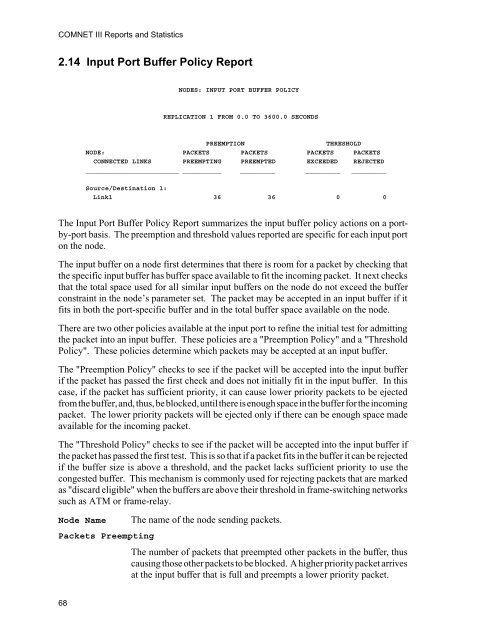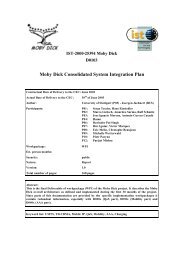COMNET III
COMNET III
COMNET III
You also want an ePaper? Increase the reach of your titles
YUMPU automatically turns print PDFs into web optimized ePapers that Google loves.
<strong>COMNET</strong> <strong>III</strong> Reports and Statistics<br />
2.14 Input Port Buffer Policy Report<br />
NODES: INPUT PORT BUFFER POLICY<br />
REPLICATION 1 FROM 0.0 TO 3600.0 SECONDS<br />
PREEMPTION<br />
THRESHOLD<br />
NODE: PACKETS PACKETS PACKETS PACKETS<br />
CONNECTED LINKS PREEMPTING PREEMPTED EXCEEDED REJECTED<br />
________________________ __________ _________ _________ _________<br />
Source/Destination 1:<br />
Link1 36 36 0 0<br />
The Input Port Buffer Policy Report summarizes the input buffer policy actions on a portby-port<br />
basis. The preemption and threshold values reported are specific for each input port<br />
on the node.<br />
The input buffer on a node first determines that there is room for a packet by checking that<br />
the specific input buffer has buffer space available to fit the incoming packet. It next checks<br />
that the total space used for all similar input buffers on the node do not exceed the buffer<br />
constraint in the node’s parameter set. The packet may be accepted in an input buffer if it<br />
fits in both the port-specific buffer and in the total buffer space available on the node.<br />
There are two other policies available at the input port to refine the initial test for admitting<br />
the packet into an input buffer. These policies are a "Preemption Policy" and a "Threshold<br />
Policy". These policies determine which packets may be accepted at an input buffer.<br />
The "Preemption Policy" checks to see if the packet will be accepted into the input buffer<br />
if the packet has passed the first check and does not initially fit in the input buffer. In this<br />
case, if the packet has sufficient priority, it can cause lower priority packets to be ejected<br />
from the buffer, and, thus, be blocked, until there is enough space in the buffer for the incoming<br />
packet. The lower priority packets will be ejected only if there can be enough space made<br />
available for the incoming packet.<br />
The "Threshold Policy" checks to see if the packet will be accepted into the input buffer if<br />
the packet has passed the first test. This is so that if a packet fits in the buffer it can be rejected<br />
if the buffer size is above a threshold, and the packet lacks sufficient priority to use the<br />
congested buffer. This mechanism is commonly used for rejecting packets that are marked<br />
as "discard eligible" when the buffers are above their threshold in frame-switching networks<br />
such as ATM or frame-relay.<br />
Node Name<br />
Packets Preempting<br />
The name of the node sending packets.<br />
The number of packets that preempted other packets in the buffer, thus<br />
causing those other packets to be blocked. A higher priority packet arrives<br />
at the input buffer that is full and preempts a lower priority packet.<br />
68
















